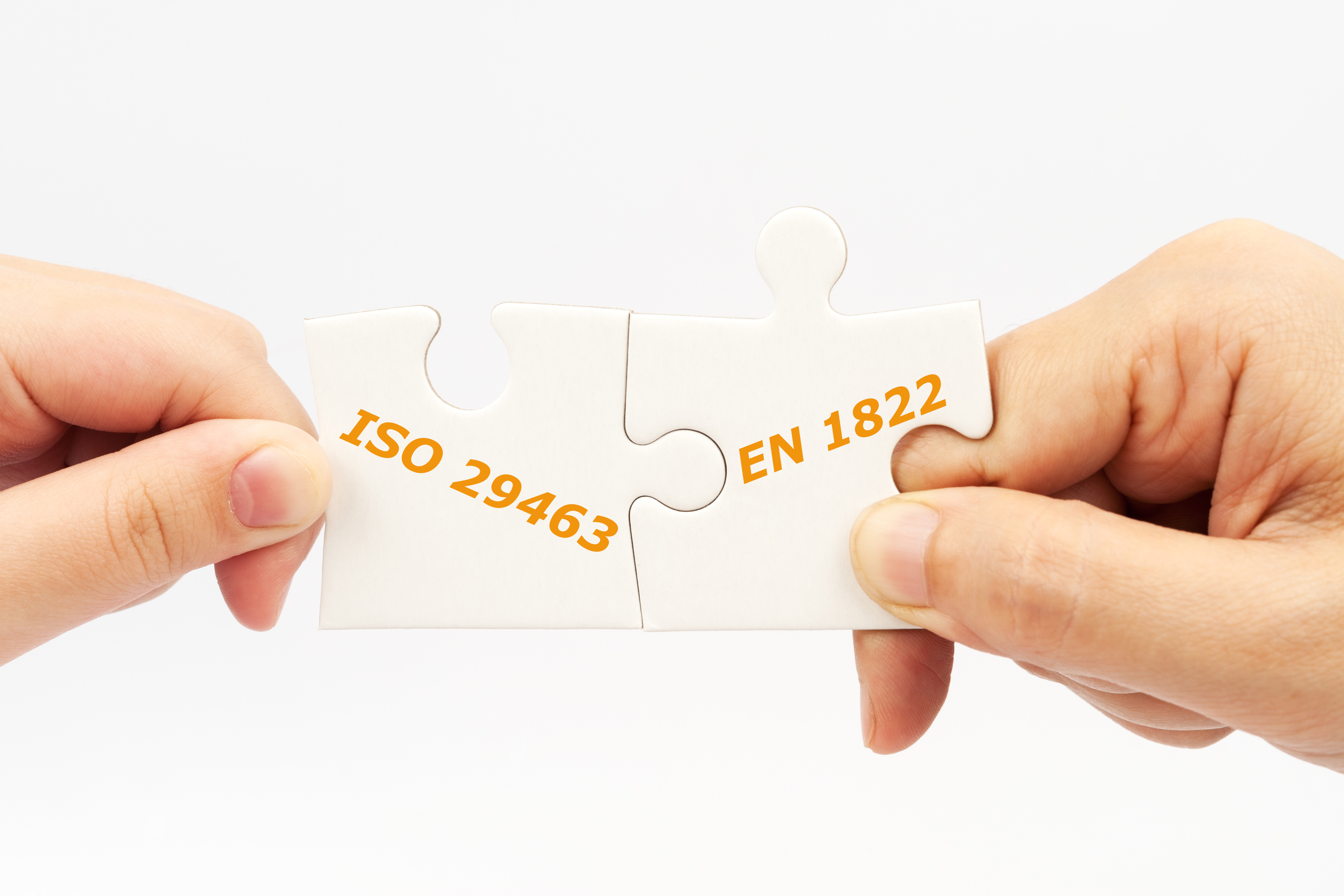
The new standard has its roots in EN 1822, and defines 13 different filter classes ranging from ISO 15 E to ISO 75 U.

There are many standards for HEPA filters. Intended to provide clarity in this maze of standards, ISO 29463 is derived from EN 1822, which defines the EPA, HEPA and ULPA filter classes commonly found in industrial use.
ISO 29463 maintains the filter designations EPA, HEPA and ULPA while replacing filter classes E10-E12, H13-H14 and U15-U17 with the following 13 filter classes:| Designation | Filter Groups according ISO 29463 |
|---|---|
| EPA Filter (efficient particulate air filter) | ISO 15 E - ISO 30 E |
| HEPA Filter (high efficiency particulate air filter) | ISO 35 H - ISO 45 H |
| ULPA Filter (ultra low penetration air filter) | ISO 50 U - ISO 75 U |
The new ISO 29463 does not replace the EN 1822 standard. EN 1822 will continue to be valid!

In 1998 EN 1822 came into effect. This was the first standard, which established a filter classification system for HEPA filters based on filtration process theory. EN 1822 also introduced the evaluation criterion MPPS (Most Penetrating Particle Size). MPPS is the particle size at which the air filter has its lowest arrestance. Not just a whim of nature, MPPS relates directly to physical mechanisms in the filtration process.
The U.S. takes a different approach for filter classification of HEPA filters. The mother of all test procedures for these filters in the U.S. is MIL-STD-282, which was introduced in 1956. Other test procedures include e.g. IEST-RP-CC001 and IEST-RP-CC007. Each test procedure specifies certain particle sizes at which efficiency is evaluated. Depending on the filter class evaluated, this is done at 0.3 µm, 0.1 - 0.2 µm or 0.2 - 0.3 µm.


In October 2011, the International Organization for Standardization (ISO) published ISO 29463 Parts 1-5 with the goal of accelerating harmonization of various filter standards used in the United States and Europe. Up to that time, ISO 29463 had coexisted in parallel with EN 1822 and the U.S. test procedures.
At the European level, however, EN 1822-1 "Classification, performance testing, marking" will continue to exist in a revised version. The revised standard will make reference to parts 2-5 of ISO 29463. Put in simple terms, EN 1822 will have its own classification system (Part 1) for air filters but will test them according to ISO 29463 Parts 2-5. However, there will still be one difference between the leakage test methods specified in the two standards. While ISO 29463:2017 Part 1 specifies five methods, EN 1822 Part 1 has only three.
| ISO 29463 Part 1: in accordance with filter design |
EN 1822 Part 1 in accordance with filter design |
|---|---|
| Scan leak test | Scan leak test |
| Oil thread leak test | Oil thread leak test |
| Efficiency leak test for 0.3 µm to 0.5 µm |
Efficiency leak test for 0.3 µm to 0.5 µm |
| Aerosol photometer leak test | |
| PSL leak test |
The requirements of EN 1822 Part 1 for leak testing of air particulate filters are stricter than those of ISO 29463. EN 1822 explicitly excludes the use of aerosol photometers. With regard to permissibility of PSL leak testing, the standard is not as clear. Part 1, Paragraph 7.3 states: "Possible aerosol substances include but are not limited to DEHS, PAO and PSL". This reference, apparently permitting use of PSL testing, is however of limited relevance to actual practice. Test procedures using PSL are very cost-intensive and therefore only rarely used.
As noted above, ISO 29463 maintains the EPA, HEPA und ULPA filter classes as specified in EN 1822. Evaluation in the new ISO standard is also based on particle arrestance at MPPS (Most Penetrating Particle Size). MPPS is the particle size at which an air filter shows minimum arrestance.
However, there is one difference in particulate filter classification between the two standards. EN 1822 classifies a particulate filter with an arrestance of e.g. 99.9993 % at its MPPS as HEPA filter class H14. When evaluated according to ISO 29463, however, this same air filter is classified as ULPA filter class ISO 50 U. As a ULPA filter under ISO 29463, it is subjected to other leakage test procedures than is the case under EN 1822.
Furthermore the ISO 29463 starts with the filter group ISO 15 E, which is equivalent to the filter class E11 according EN 1822. Consequently does not cover a counterpart to the EPA filter class E10. In contrast shows the test standard ISO 16890 with the filter group ISO ePM1 >95% an equivalent to the filter class E10.
Here is a compararison between the filter classes defined in ISO 29463 and EN 1822:
| Overall Value | Local Value | ||||
|---|---|---|---|---|---|
| Filter Classes
according EN 1822-1 |
Filter Groups
according ISO 29463 |
Efficiency |
Penetration |
Efficiency |
Penetration |
| E10 | - | ≥ 85% | ≤ 15% | - | - |
| E11 | ISO 15 E | ≥ 95% | ≤ 5 % | - | - |
| ISO 20 E | ≥ 99% | ≤ 1% | - | - | |
| E12 | ISO 25 E | ≥ 99.5% | ≤ 0.5% | - | - |
| ISO 30 E | ≥ 99.90% | ≤ 0.1% | - | - | |
| H13 | ISO 35 H | ≥ 99.95% | ≤ 0.05% | ≥ 99.75% | ≤ 0.25% |
| ISO 40 H | ≥ 99.99% | ≤ 0.01% | ≥ 99.95% | ≤ 0.05% | |
| H14 | ISO 45 H | ≥ 99.995% | ≤ 0.005% | ≥ 99.975% | ≤ 0.025% |
| ISO 50 U | ≥ 99.999% | ≤ 0.001% | ≥ 99.995% | ≤ 0.005% | |
| U15 | ISO 55 U | ≥ 99.9995% | ≤ 0.0005% | ≥ 99.9975% | ≤ 0.0025% |
| ISO 60 U | ≥ 99.9999 % | ≤ 0.0001% | ≥ 99.9995% |
≤ 0.0005% | |
| U16 | ISO 65 U | ≥ 99.99995% | ≤ 0.00005% | ≥ 99.99975% | ≤ 0.00025% |
| ISO 70 U | ≥ 99.99999% | ≤ 0.00001% | ≥ 99.9999% | ≤ 0.0001% | |
| U17 | ISO 75 U | ≥ 99.999995% | ≤ 0.000005% | ≥ 99.9999% | ≤ 0.0001% |